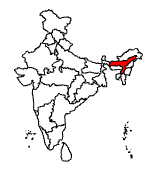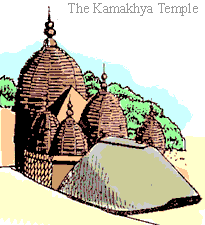
Dimdima
Online Children's Magazine from India

Dimdima
Online Children's Magazine from India
Assam is the largest and most populated of the northeastern states. It derives its name from the Sanskrit word ‘asoma’ meaning ‘peerless’.
Area : Approximately 78,438 sq km
Population : 2,66,38,407. Assamese and tribals like the Garos, Nagas, Kukis, Khasis and Bodos.
Languages : Assamese, though Bengali is spoken in the Barak Valley.
Capital : Dispur
Location : South of Arunachal Pradesh. It has international boundaries with Bhutan and Bangladesh. It is geographically divided into two important physical regions : the Barak Valley and the Brahmaputra Valley.
Traditional Dress : Men: dhoti & kurta. Women: a mekhala (long skirt) with a riha and a dupatta.
Major Towns : Guwahati is famous for its Kamakhya (Kali) Temple and is a centre of Tantric cult and Shakti worship . The Guwahati Tea Auction Centre is the world’s biggest centre for CTC tea (Assam contributes 15.6% of the world’s tea production and 55% of the country’s output). Sualkachi is a famous silk centre (Assam is the world’s largest producer of the golden coloured muga silk); Jorhat, well known for its tea gardens, has the oldest extant oil rig; Sibsagar, the ancient capital of the Ahoms, a Buddhist Tai tribe who ruled from the 13th to the 17th centuries, is well known for its massive temples.
River : The 2900-km long Brahmaputra and its 120 tributaries.
Natural Resources : Oil (Assam is the first state in India where oil was struck : in 1889 at Digboi, where Asia’s first oil refinery was constructed), natural gas, coal, limestone, refractory clay and dolomite.
Tourist Sports : The Kaziranga National Park, world famous for its rare one-horned rhinos (which Marco Polo mistook for the legendary unicorns); the Manas National Park, famous for its tigers.
Major Festival Bihu, the harvest festival.
Annual Rainfall : Between 178 and 305cm, one of the highest in the world.
Assam was given its name by the Ahoms who invaded the region in about A.D. 1215. The Ahoms were a Mongoloid tribe with roots in Burma. They gradually consolidated their position in Assam. They adopted the local language, customs and the Hindu religion.
They established a strong monarchy that lasted six centuries, even withstanding the might of the Mughals.
To rule their large kingdom the Ahom rulers appointed Bharphukans or viceroys. The last of the viceroys, a man named Badanchandra, was greedy for power and sought Burmese help. The Burmese took advantage of the situation. They overthrew the Ahoms, dismissed Badanchandra and established political control in Assam. The Ahoms appealed to the British for help. The presence of the Burmese was a threat to the East India Company's commercial interests. The British defeated the Burmese and took possession of Assam.
Assam today is a shadow of its former self. Between 1948 and 1972 it was reduced to one-third its original size. At the time of partition, Sylhet, a predominantly Muslim area, was merged with East Pakistan (now Bangladesh). In 1948 the North East Frontier Agency (the present Arunachal Pradesh) was separated from Assam for security reasons. In the 1960's and 70's the states of Nagaland, Meghalaya and Mizoram were carved out from it.
The famous tea gardens of Assam were set up by the British in 1836. Most of the tea gardens are found at Dibrugarh, Jorhat and Sibsagar.
The tea garden workers wear colourful, bamboo-and-cane headgear called Japi.
Besides tea, Assam is known for the Kamakhya temple and the one-horned rhinoceros which is found in the Kaziranga National Park.
Its oldest relic is a 5th century stone door dating back to the Gupta period in the tiny village of Da Parbatia.
Other Places of Interest
Sibsagar, once the capital of the Ahoms is dominated by a large water tank from which it gets its name.
The Shivdol temple here draws large crowds during Shiv Ratri.
Joysagar at the edge of the town may be the country's largest man-made lake.
Majuli, in the midst of the Brahmaputra is the world's largest inhabited river island. It is revered for its Vaishnavite monasteries called Satras.
The Namdang stone bridge at Charideo was carved out of a single boulder hundreds of years ago. A busy highway runs through it today.
A Bhutia fair in Darsanga (close to Bhutan's border) has the Bhutanese coming in to sell their curios.


Dimdima is the Sanskrit word for ‘drumbeat’. In olden days, victory in battle was heralded by the beat of drums or any important news to be conveyed to the people used to be accompanied with drumbeats.
Bharatiya Vidya Bhavan
K. M Munshi Marg,
Chowpatty, Mumbai - 400 007
email : editor@dimdima.com
Bharatiya Vidya Bhavan
505, Sane Guruji Marg,
Tardeo, Mumbai - 400 034
email : promo@dimdima.com
Dimdima.com, the Children's Website of Bharatiya Vidya Bhavan launched in 2000 and came out with a Printed version of Dimdima Magazine in 2004. At present the Printed Version have more than 35,000 subscribers from India and Abroad.